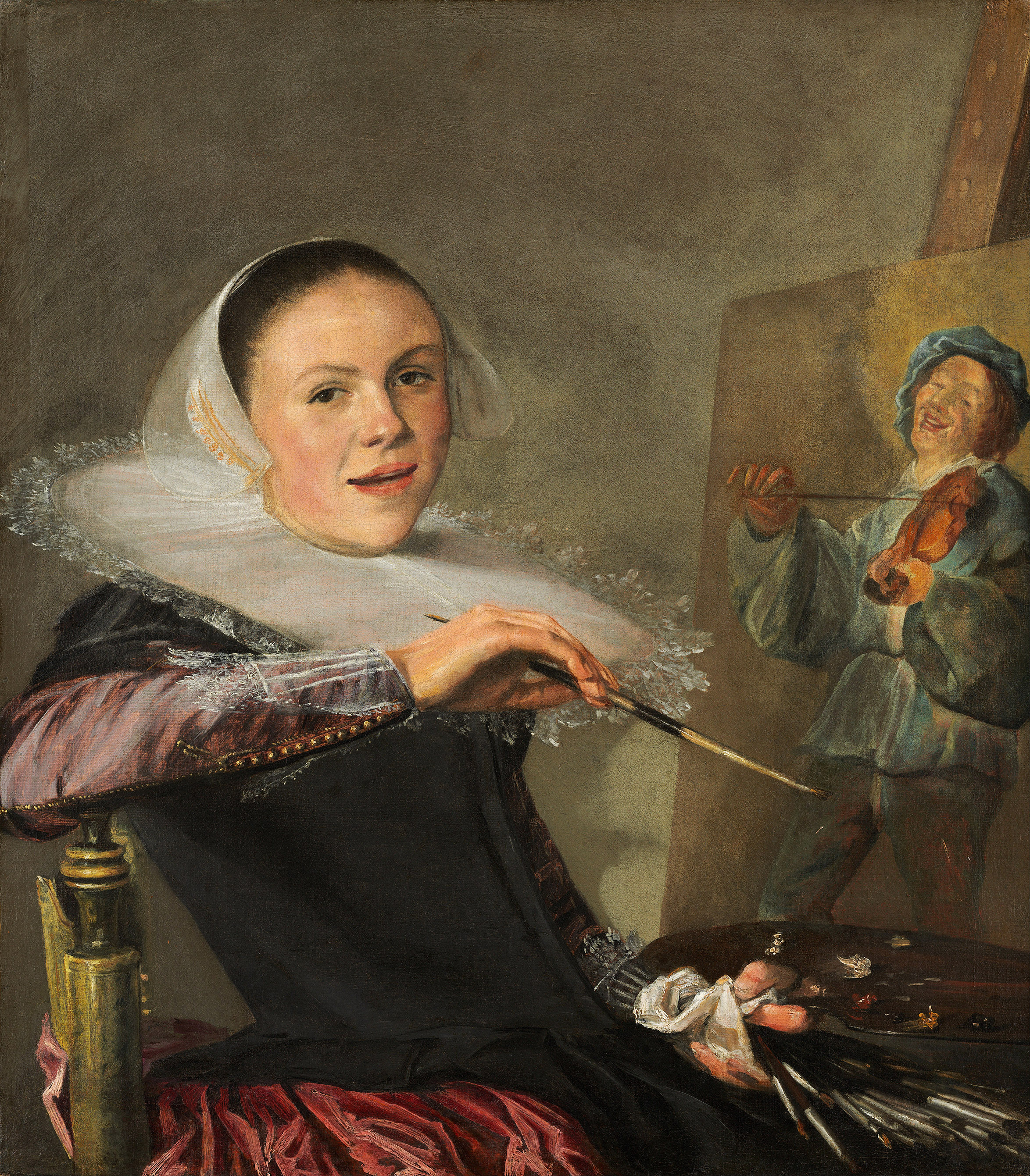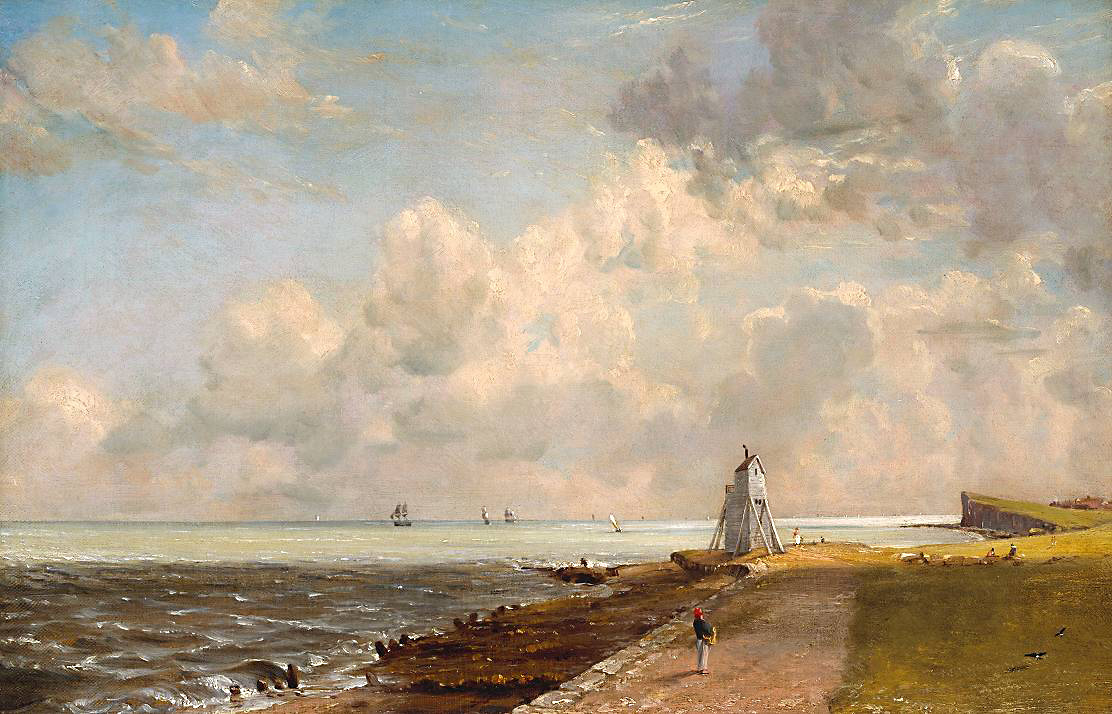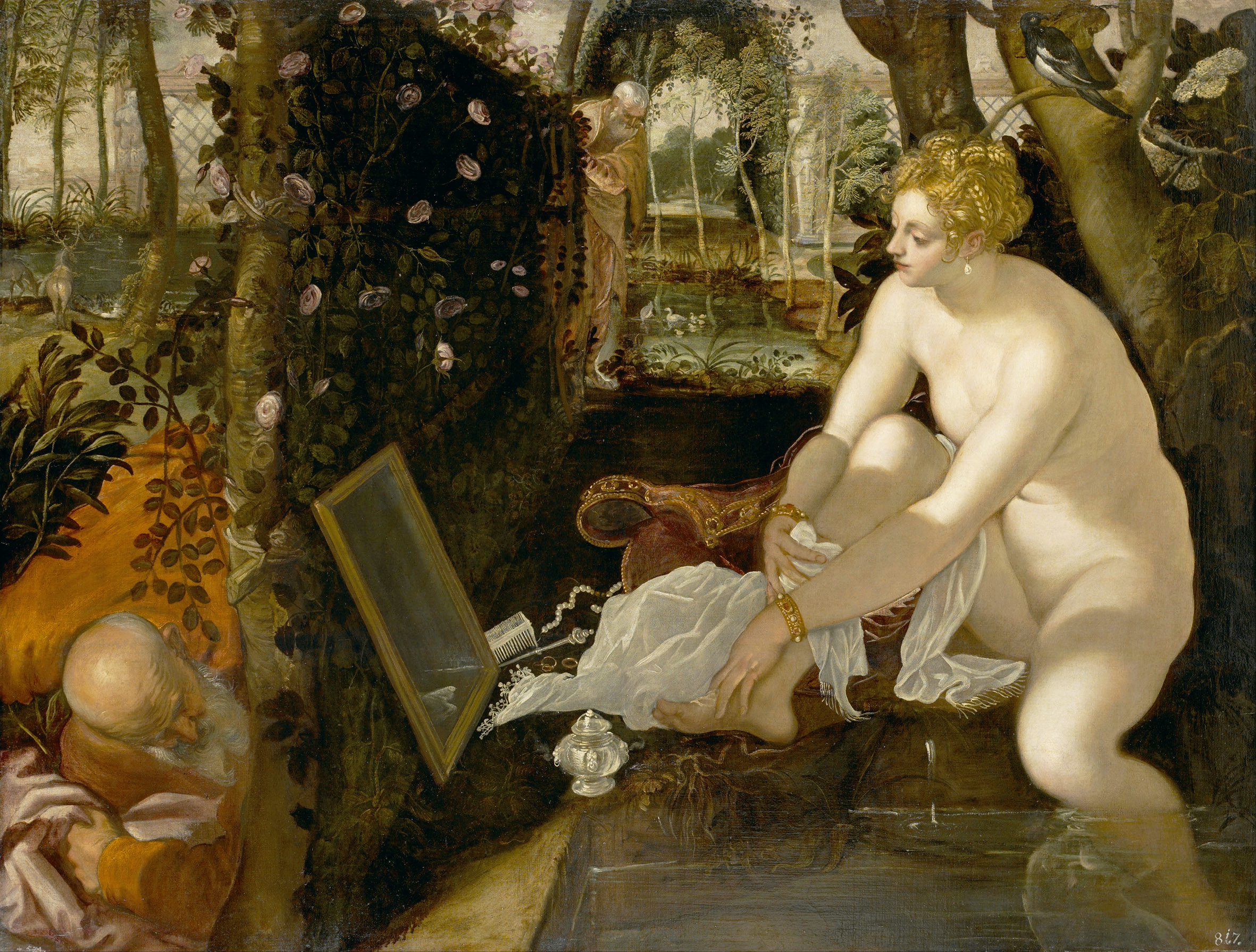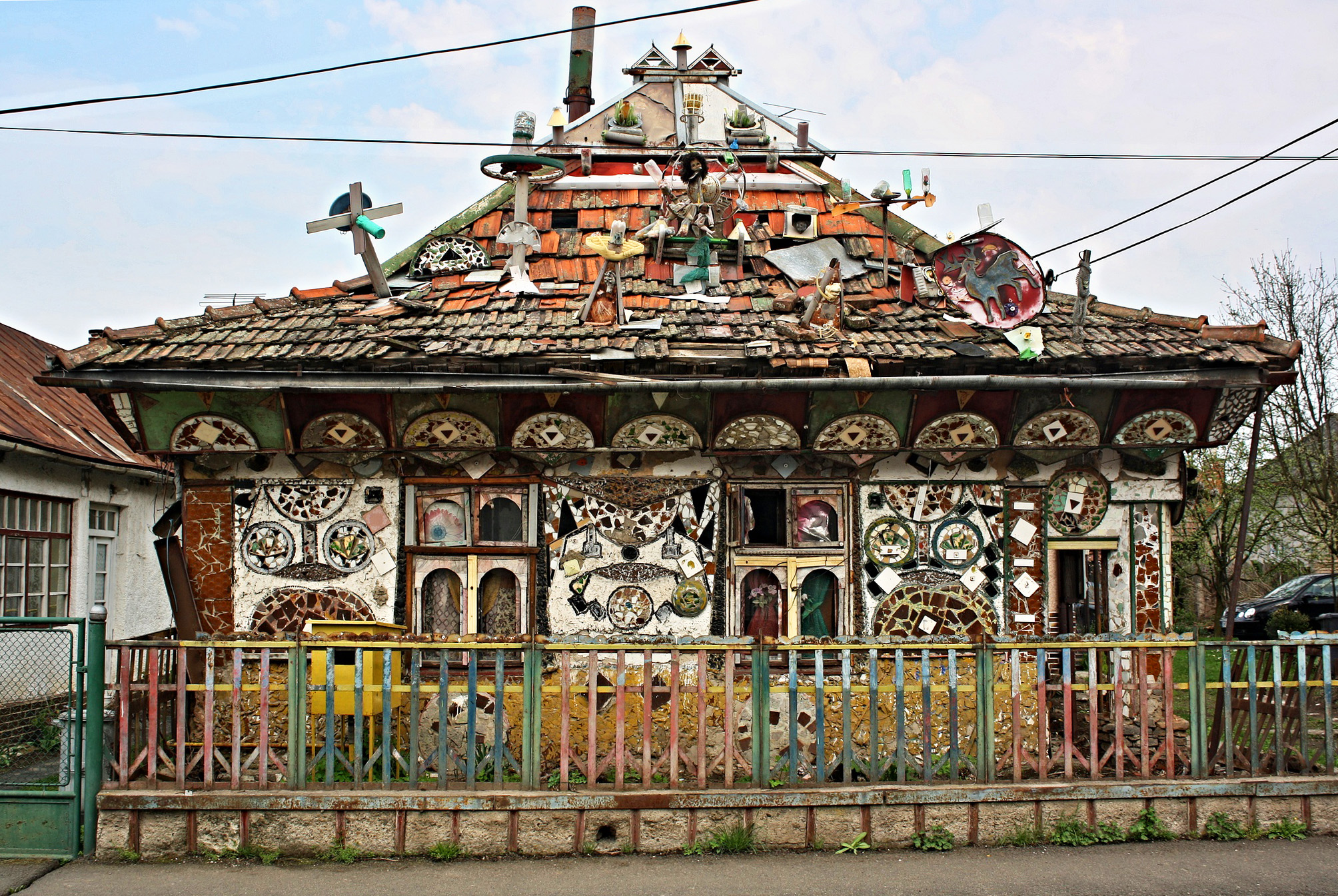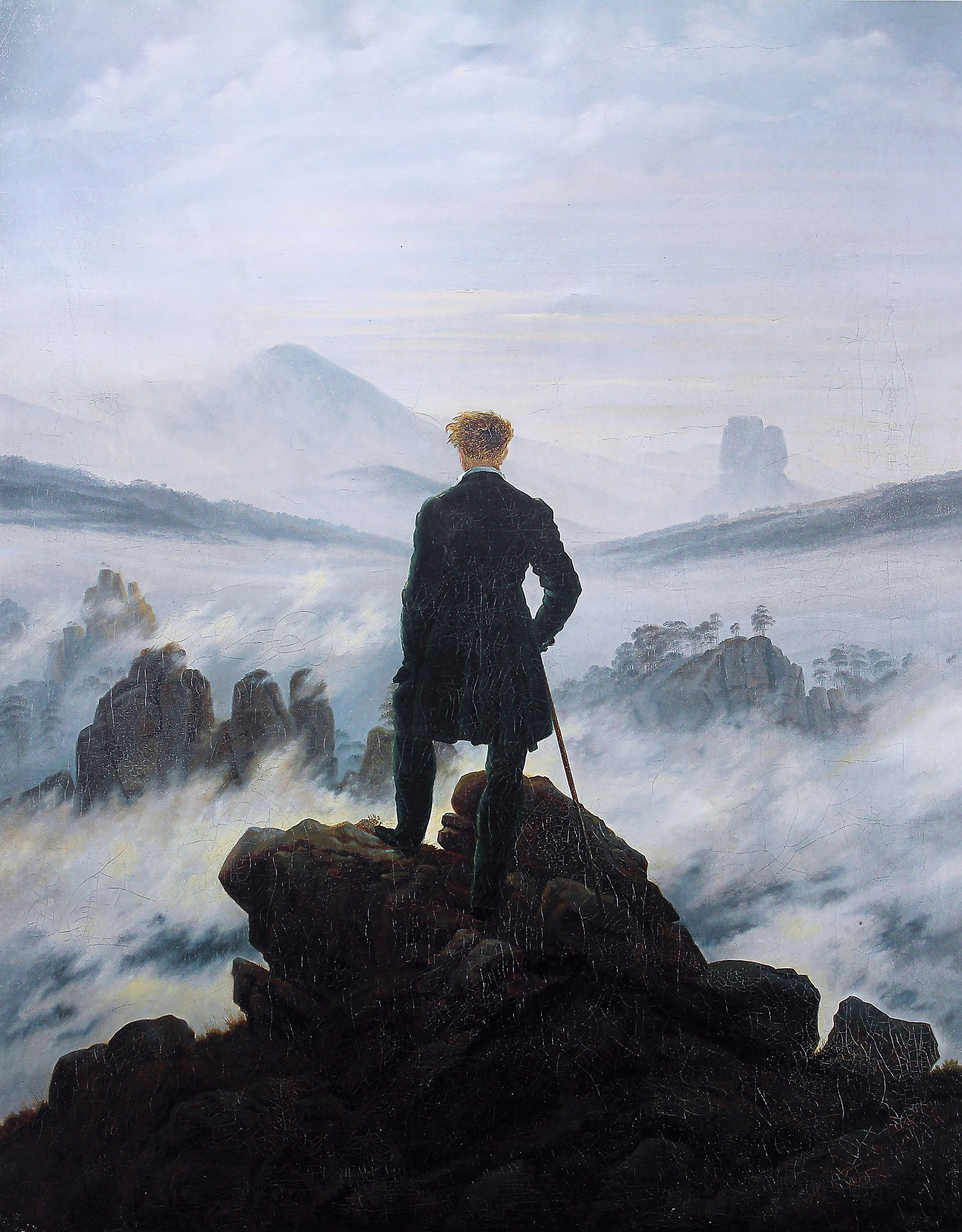
It took its place in art slowly, with hesitation. For a long time it raised suspicion. But in the end it blossomed and started brightening up portraits and sculptures. Look into the eyes of the people who are all smiles!
In 1998, the art historian Angus Trumble got invited to a conference for dentists and oral and maxillofacial surgeons. The medics wanted to know how the canons of ‘a beautiful face’ had changed in portraiture. The academic delivered, paying special attention to how the mouth was presented in the arts. Simultaneously, he understood how difficult it is to draw teeth and not turn the portrait into an image of a naked skull or a terrible caricature. He also reminded his listeners that in old times, only a few could show off a complete set of white teeth. As Trumble observed, usually it is only the peculiar characters who are shown with open mouths and bared teeth: lecherous old men, penny-pinchers, drunks, madmen, monsters or people in religious ecstasy. The worst, defective teeth are presented by Christ’s sneering tormentors. Up until the 17th century, in Western culture there was a widespread conviction that only children, drunks and dunces smiled broadly. In his 1703 treatise on manners, Jean-Baptiste de La Salle said: “[…] some people lift their upper lip so much that their teeth are shown in the process. It is completely against the decorum, which does not allow for their exposure, since nature equipped us with lips to cover them.”
The dentists might have been surprised to hear that for centuries a wide smile was not fashionable and those sitting for portraits were not told to say ‘cheese’. According to the painter Miss La Creevy, a character from the Charles Dickens’ novel The Life and Adventures of Nicholas Nickelby, sitters were difficult to satisfy. Some thought that being serious made them look older, others got annoyed by frivolous expressions. As the young artist advises, there are only two portrait styles: a serious one and a smirking one: ‘‘Look at the Royal Academy! All those beautiful shiny portraits of gentlemen in black velvet waistcoats, with their fists doubled up on round tables, or marble slabs, are serious, you know; and all the ladies who are playing with little parasols, or little dogs, or little children – it’s the same rule in art, only varying the objects – are smirking. […] We always use the serious for professional people (except actors sometimes), and the smirk for private ladies and gentlemen who don’t care so much about looking clever.”
Despite bad press, smiling people can be found in each and every museum of art – sometimes hidden in the margins, often in surprising contexts. The self-confident, indeed nonchalant, smile quivers in the corners of Judith’s mouth as she holds the head of Holofernes in the painting by Lucas Cranach the Elder. Jan Steen’s feasters laugh loudly and coarsely, Frans Hals’s old witch Malle Babbe chortles brazenly. Caravaggio’s Amor Victorious shocked its contemporaries not with his exposed nudity – his unashamedly beaming face was even harder to accept.
Kouros’s archaic smile
Marcus Tullius Cicero reflected on what laughter is and what provokes it. He was astonished that so many different body parts participate in it at the same time, and that once you start laughing, it’s difficult to control it. Trying to find a general definition, the orator concluded that laughter is caused by discrepantia – a discrepancy, an incongruity (its model example could be Laurel and Hardy). But a lot seems to point to the fact that even though people have been laughing since the beginning of history, there are no things found universally funny that make everybody laugh, regardless of culture, era or context. The inquisitive Pliny the Elder asked precise, scientific questions. In which organ does laughter begin? Why is it triggered by tickling under the arms? He also wondered when newborns learn to laugh. He concluded that it is 40-day-old babies who smile for the first time. With one exception: the Persian prophet Zoroaster, who laughed out loud from the day he was born, surely a sign of his divinity.
Experts in ancient art tried to explain why there is so little laughter in it. Is it to do with the seriousness of the genre? Greek sculptures are predominantly religious. Or perhaps the Greeks thought that smiling deforms the features? Helpless archaeologists even speculated that the smile might have been simply a technical challenge. But, of course, there are statues of kouroi and korai with the corners of their mouths lifted. In the past, experts speculated that these serene, youthful figures were proof of the Ionic era’s joy of life, in contrast to the severity of the Doric style. But it turned out that the ‘archaic smile’ does not in fact express spontaneous emotions, like friendliness, amusement or irony. Statues of kouroi fit a lot of precise conventions: a straight-backed, naked young man with his arms down, fists tightened, his left foot slightly in front of his right one. The subtle smile seems to be inconsistent with the formal, stiff pose. But this seemingly blissful expression only completes the decorum – it signals that the presented person is alive, healthy and fit. It is also possible that the ‘smile’ was there to highlight the noble features and the high social status of the ‘portrayed’. In Greek cities, the aristocrats were called galeontes – the smiling ones. Apart from that, seeing statues of beautifully-built, cheerful young men must have been a pleasure for the Greeks, comparable to watching oiled, vigorous athletes during the Olympic games.
The lips of the kouros from the Metropolitan Museum in New York have only been marked with several incisions; the smile, if we can call it that, is discreet and minimal. On the other hand, the Rampin Rider from the Louvre is undoubtedly smiling. Moreover, it is a mysterious smile, as if sprinkled with irony. But even this smile should not be confused with an emotional storm: the competitor in laurels on his head surely celebrates his victory. And anyway, a similar ‘archaic smile’ appeared also in completely ‘inappropriate’ contexts. Statues of kouroi played votive functions; they were also placed on graves. Even dying warriors in the Aegina Pediment still have smiling faces. Another mystery are the expressions of ritual or theatre masks. Can Gorgon Medusa’s wide-open mouth with bared teeth and stuck out tongue be called a smile? It wasn’t just her gaze but also her derisive laughter that could turn the enemy into stone.
Angelic moods
The ambiguous, archaic smile inspired artists for many centuries. The 13th-century sculptor from the Parisian Notre Dame must have taken inspiration for the face of his angel from Greek art. But even an expert in mediaeval art must think twice before declaring that the artist wanted to show happy or even laughing figures.
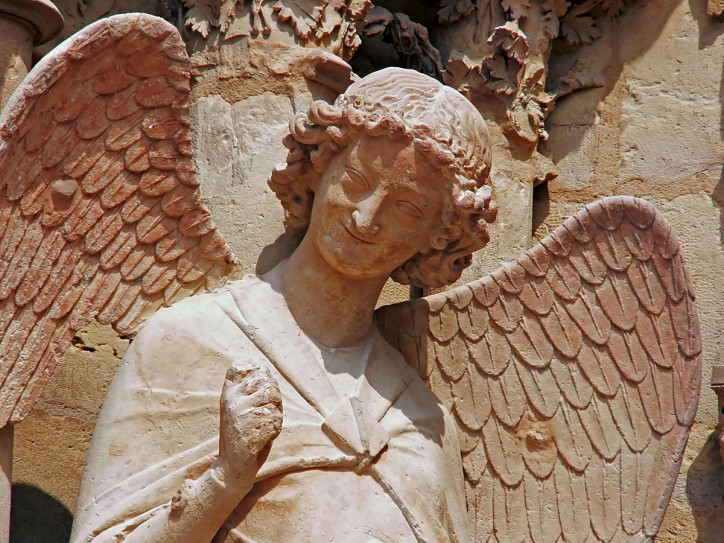
In painting or sculpture, mimetics and gestures are not always signs of spontaneous emotions; at times they also have symbolical meaning. For Ovid, scratching one’s cheeks was an expression of despair, but Sienese master Duccio painted Mary Magdalene weeping for Christ with her arms raised above her head and her hands wrung. Mediaeval art does not lack smiles, but sometimes we can’t tell their meaning or sources. Foolish Virgins who forgot to bring oil for their lamps are condemned to eternal damnation. On the façade of the Strasbourg Cathedral, despite this hopeless situation, they just giggle idiotically. Maniacal laughter is also the reaction of the damned ones to the decision of the Last Judgement in the tympanum of the Bamberg Cathedral. The demon dragging them to hell even stuck his tongue out in delight. However, on the faces of the chosen ones only discreet, subtle smiles appear. They are sitting on the right-hand side of the Father and are going straight to heaven. In paintings, serene faces are those of saints and the blessed. A wide smile also appears in the scene of Annunciation in Konstanz Cathedral, on the face of the angel bringing the good news to the surprised Mary.
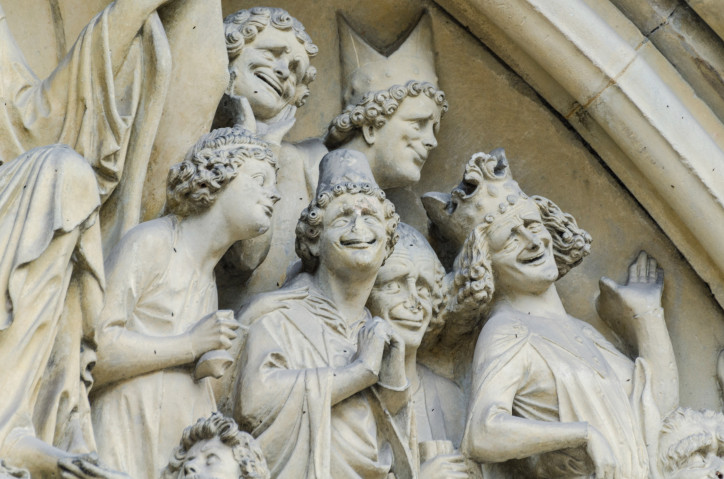
The most famous angelic smile belongs to the divine messenger carved in the fourth or fifth decade of the 13th century in Reims. His softly contoured face is surrounded by locks held by a bejewelled headband. The angel’s smile is noble, grand and slightly ironic. It’s not just the lips that are smiling, but also the almond-shaped eyes. World War I added to the legend of this statue. In September 1914, a German bomb shattered it to pieces. The angel was saved by the abbot and meticulous reconstructed. Today, he smiles again from the height of the façade. The features of neighbouring statues from Reims are also natural, mimetic, full of emotion. However, they should not be interpreted as ‘based on nature’. The 13th-century artist was a skilled observer, but he was also inspired by ancient art. His animated figures from the cathedral façade are not portraits, but physiognomical studies. According to the ‘science’ initiated by Aristotle, there are four types of human temperament: sanguine, choleric, phlegmatic and melancholic. Additionally complexions, types of hair, movements or gestures are also assigned to those categories and compared to animal customs. Varied, animated figures in Reims could be interpreted as a parade of personality types. Reims sculptors were not alone in their interests. Already in the 12th century, expressive, sometimes almost caricatural faces appeared in the decorations of the cathedrals in Trondheim and Lincoln. But, at that time, they were placed high up under the roof; not visible to the wider public. In Reims, the faces are dynamic and very visible. And they are not distorted in an over-the-top, symbolical grimace. The face the famous angel pulls seems to be spontaneous and not just conventional or strained. On the other hand, his smile does not result from a fleeting mood. It carries a divine blessing.
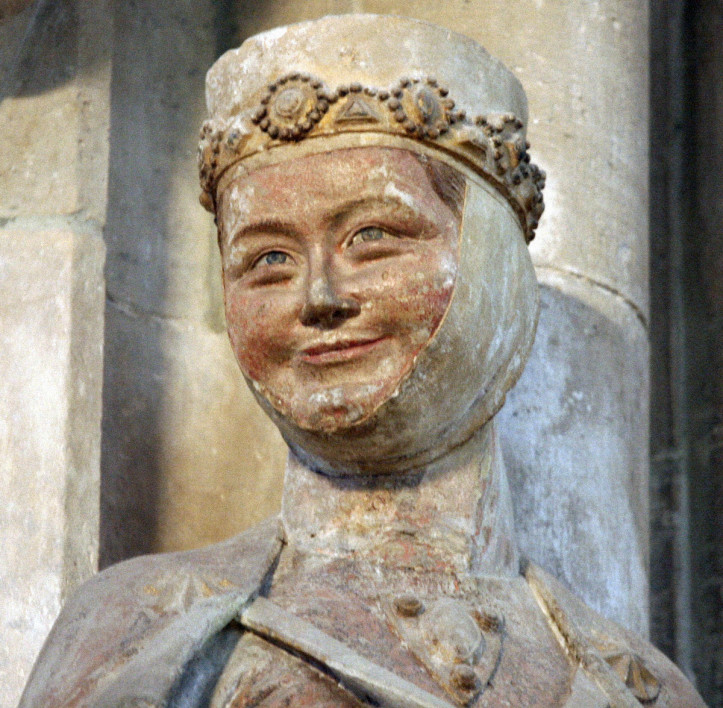
One of the first figures in art history shown smiling in a genuine way (and not a saint) is the Polish princess Reglindis. She was the daughter of Bolesław the Brave and she married Herman, the Margrave of Meissen. They ruled from Naumburg Castle and were one of the founders of the local cathedral. In the 13th century, figures of its 12 donors were placed in the western choir of the church. The presence of secular people in the sacred space was justified by their merits. That’s why their clothing, demeanour and gestures fit the courtly convention. At the same time, the expressions and silhouettes of the Naumburg founders are distinguished by realism unprecedented in mediaeval art. The way in which Uta holds the collar of her coat by her neck highlights the dignity of the matron. Equally, the Margravine coquettishly displays a bit of the fur lining. Severe Uta is contrasted with amused Regelindis, with her full cheeks and joyful eyes. No wonder that she is known in art history as the ‘smiling Polish woman’. Her face shimmers with emotions. But this is not a portrait: the princess lived at the beginning of the 11th century. The sculptor, who visualized her a century and a half later, was inspired by the figures of French angels and also recalled the faces of contemporary women known to him. Empress Adelaide from the Meissen Cathedral looks at her husband, Emperor Otto I, with a serene, even cheerful expression. Arguably the monarchs, founders of the great cathedral, are allowed a blissful smile in hope of salvation. But the religious pretext allowed the sculptor to show the happy face of a young woman: Adelaide casts her husband a knowing glance, as if she has just told him a joke and is awaiting his reaction.
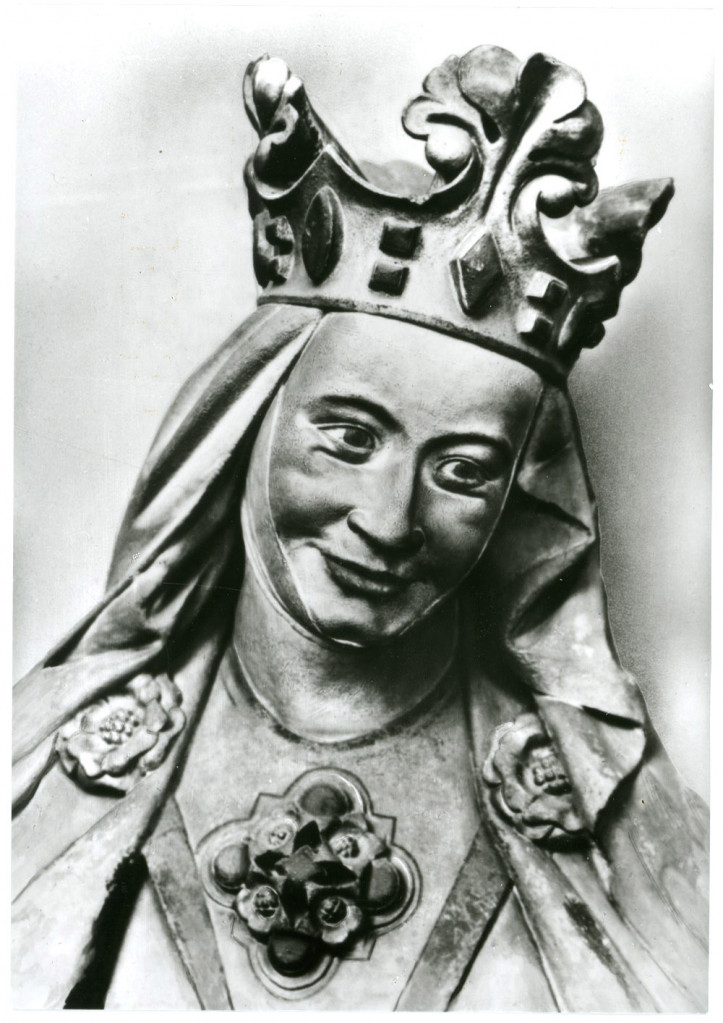
The most famous lips in the world
Christian scholars were for a long time perturbed by laughter. Church Fathers stressed that Jesus cried but didn’t laugh, and they warned against loud chortles. Outside of the excesses of carnival, it was advised to limit oneself to a subtle smile. For Gregory of Nyssa, laughter was a form of madness, accompanied by unseemly bodily loosening, agitated breathing, dilation of the cheeks, baring of the teeth and gums, breaking up of the voice. That was why demons and monsters on the margins of manuscripts cackled obscenely; that’s why fools, evildoers and damned ones laughed. But even in modern painting, which accepts the smile as an expression of personality or mood, its sense is not always immediately clear.
The title Laughing Cavalier only stuck to Frans Hals’s painting in the 19th century. The young military man is wearing a black hat upturned jauntily and a lace ruff under his chin. The decorations of his opulent costume – cornucopias and Amor’s arrows – suggest that the sitter recently got engaged. Perhaps that is why the cavalier seems to be so confident and pleased. But the corners of his lips are barely lifted, though his long, upturned moustache follows the shape of a smile. Shown in three-quarter view, he has his left hand on his hip and looks at us provocatively. The smile is not limited to the crescent-shaped lips; the emotions are transmitted first and foremost by the eyes. After all, Frans Hals was an undisputed master of the smile, able to show its varying shades. His Jester with a Lute does not smile courteously or reservedly like the self-confident cavalier. Instead, joy stemming from playing his instrument shows on his face. He is surely sending a discreet signal to a colleague from a band, sharing a sensation caused by a change of tempo or a slight dissonance. Hals’s dishevelled Gypsy Girl smiles seductively, wantonly. She is offering her sorcery, promising a prophecy or encouraging an adventure; her breasts spill out of the neckline of her white bodice.
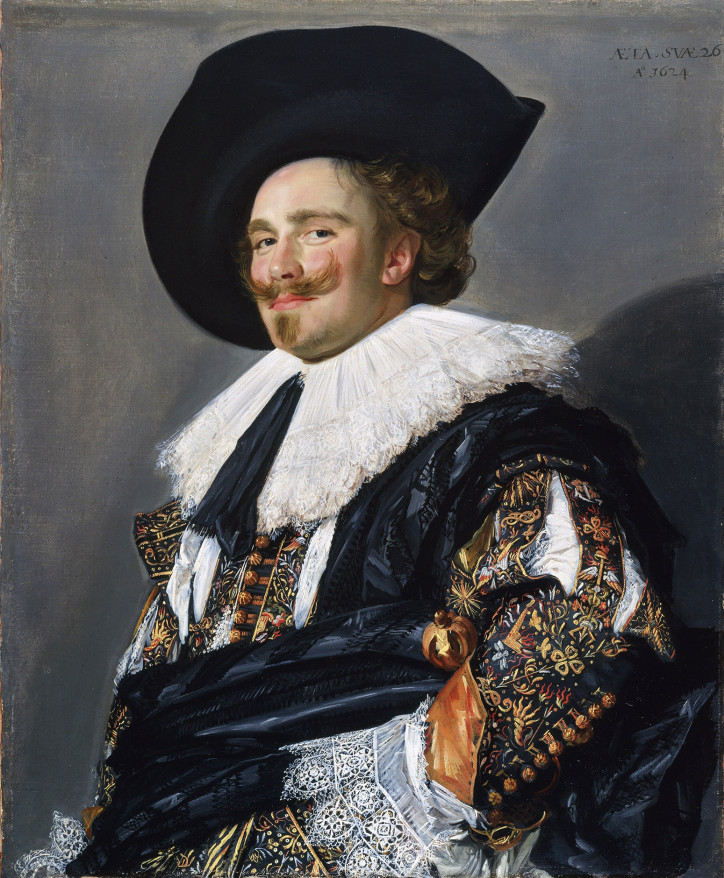
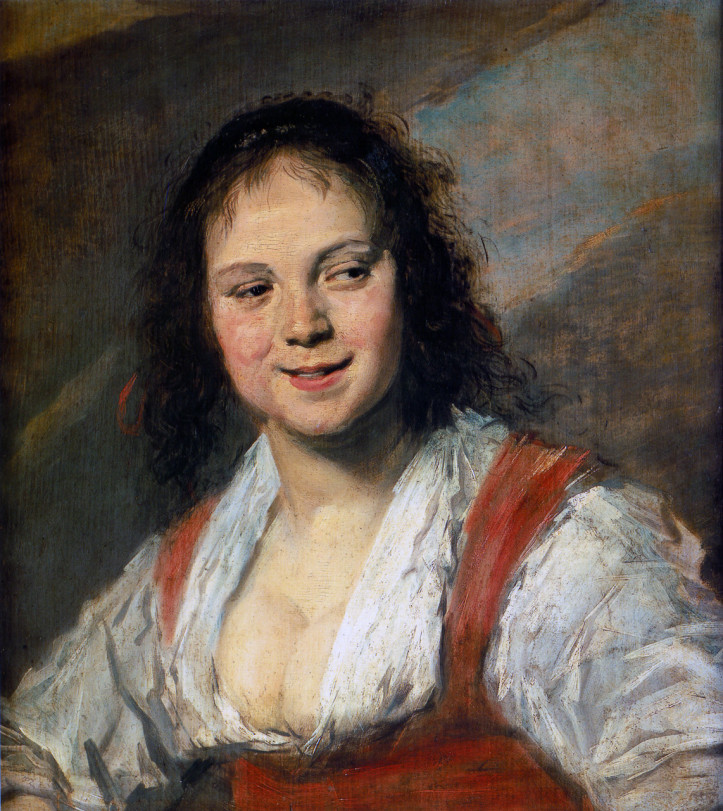
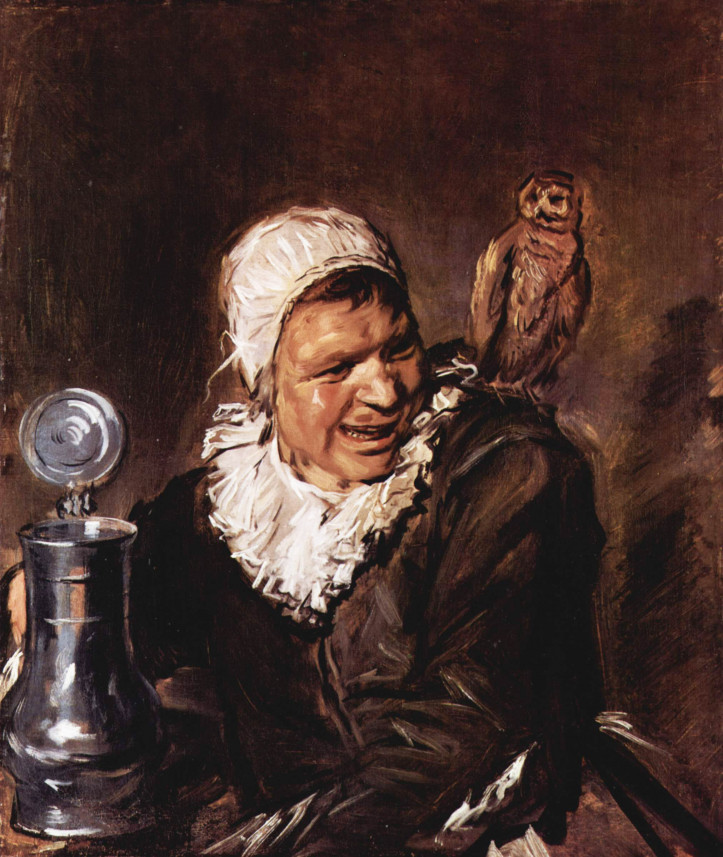
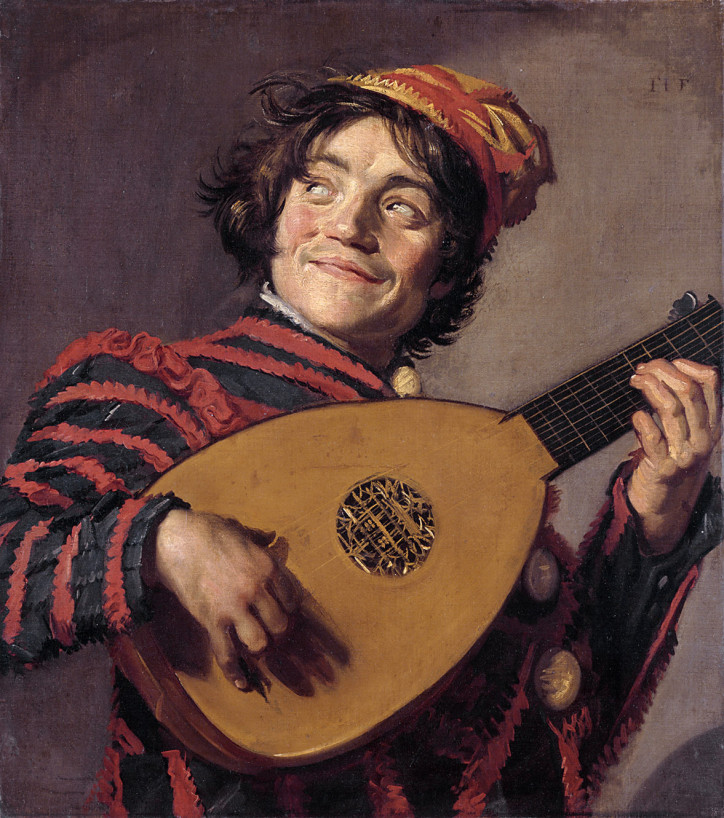
We must not leave out the most famous smile in the whole history of art: Mona Lisa’s sfumato-modelled, mysterious lips. She attracts and engages the viewer, she seduces them, self-confident and assured of her own beauty. But it is enough to look at her again – from a slightly different angle – to conclude that she had changed her mind and is looking down at us, maybe even jeering a bit. Giorgio Vasari claimed that Leonardo’s sitter was amused by clowns and flute players. Scholars argued over her for centuries. The 19th-century historian Jules Michelet admitted that the painting attracted him and haunted him. His son-in-law Alfred Dumesnil expressed it emphatically: the smile emanates a poisonous, sickly attraction. The connoisseur of Tuscan painting Bernard Berenson saw “hostile superiority” in her face and John Ruskin, famous for his fierce views, went as far as to call her a caricature. He got a response from the exalted Oxford aesthete Walter Pater: “The presence that rose thus so strangely beside the waters, is expressive of what in the ways of a thousand years men had come to desire. Hers is the head upon which all ‘the ends of the world are come,’ and the eyelids are a little weary. It is a beauty wrought out from within upon the flesh, the deposit, little cell by cell, of strange thoughts and fantastic reveries and exquisite passions.”
The only truly novel interpretation of Leonardo’s artwork was suggested in 1910 by Sigmund Freud. He concluded that by painting women with tender smiles, the master was ‘remembering’ his own mother, from whom he was separated as a child. When painting Mona Lisa’s blissful, ecstatic smile, Leonardo did not expect “such tenderness from women’s lips”. Therefore, based on the example of the Mona Lisa’s smile, the father of psychoanalysis explained the formation of sexual preference. “In all our male homosexual cases the subjects had had a very intense erotic attachment to a female person, as a rule their mother, during the first period of childhood, which is afterwards forgotten; this attachment was evoked or encouraged by too much tenderness on the part of the mother herself, and further reinforced by the small part played by the father during their childhood.”
Not less mysterious than Mona Lisa’s is the smile of Antonello da Messina’s Unknown Sailor from the Museo Mandralisca of Cefalù. We don’t know if he really was a sailor. His costume, as well as the fact that he was painted by a famous artist, suggests that he must have been a nobleman. His smile is more emphatic than the subtle lift of corners of the lips in Leonardo’s portrait. This man not only posed well; he really is in a good mood, or perhaps has a rather cheerful, kind disposition. He is not young anymore; the smile has carved deep furrows in his cheeks. His eyes also smile, ‘the sailor’ is looking at us sideways, as if wanting to pass on some secret; as if ready to wink at us.
A smile can mean a lot of things, but the Renaissance rid it of taboo – it is not an attribute of the devil anymore, nor the sign of foolishness or sin. Furthermore, painters are now interested in the human face – a singular, unique face on which varied, sometimes fleeting, emotions show. In 1630, the Dutch painter Judith Leyster portrayed herself at work. She is busy, there is a painting of a laughing violinist on her easel. But the painter herself is also in a good mood. Holding a brush in one hand and a palette in the other, she turns momentarily and looks straight at the viewer. She smiles – she is happy, self-confident. A smile does not mean debauchery now. Judith is a woman and an artist, proud of her work.
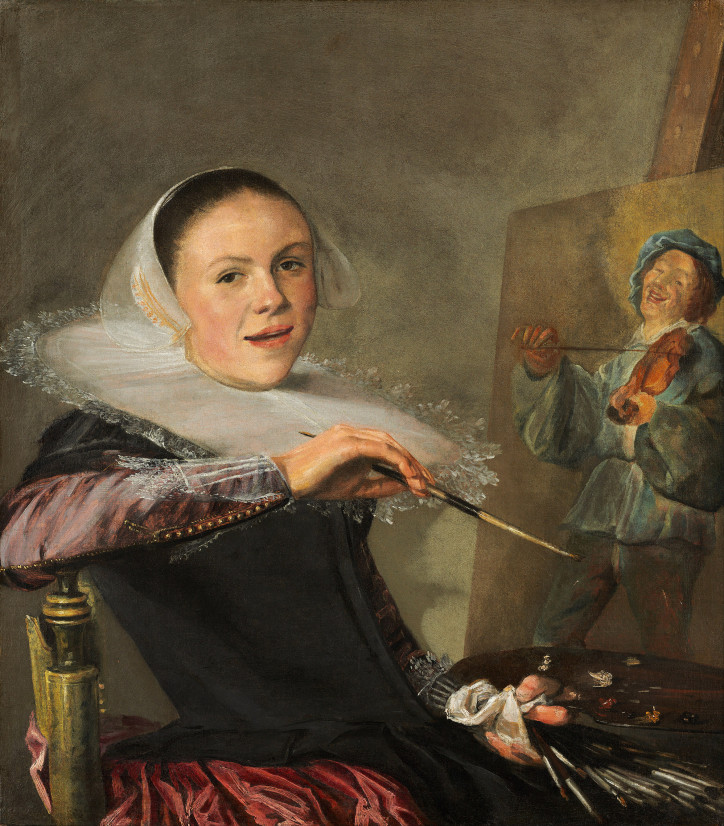
The master of self-portrait was, of course, Rembrandt. Before he stood in front of a mirror, he often dressed in historical or mythological characters’ costumes. He also presented himself in various stages of life, with its tragedies leaving marks and triumphs shining on his face. He documented moments of domestic joy, professional achievements and defeats. A lively, joyful, pert smile brightens up the face of the 20-year-old painter. Old Rembrandt laughs again in the enigmatic self-portrait from Cologne. Stooped, with saggy, soft cheeks and mouth revealing some missing teeth. A sharp, old profile appears at the edge of the painting. Is that the god Terminus announcing the forthcoming death? Surely Rembrandt does not impersonate Democritus, the laughing philosopher? Towards the end of his life, he identified more with the Greek painter Zeuxis, who died of laughter amused by his own portrait of an old woman. The Dutchman most likely also awaits death with a brush in his hand, laughing at his own artwork.
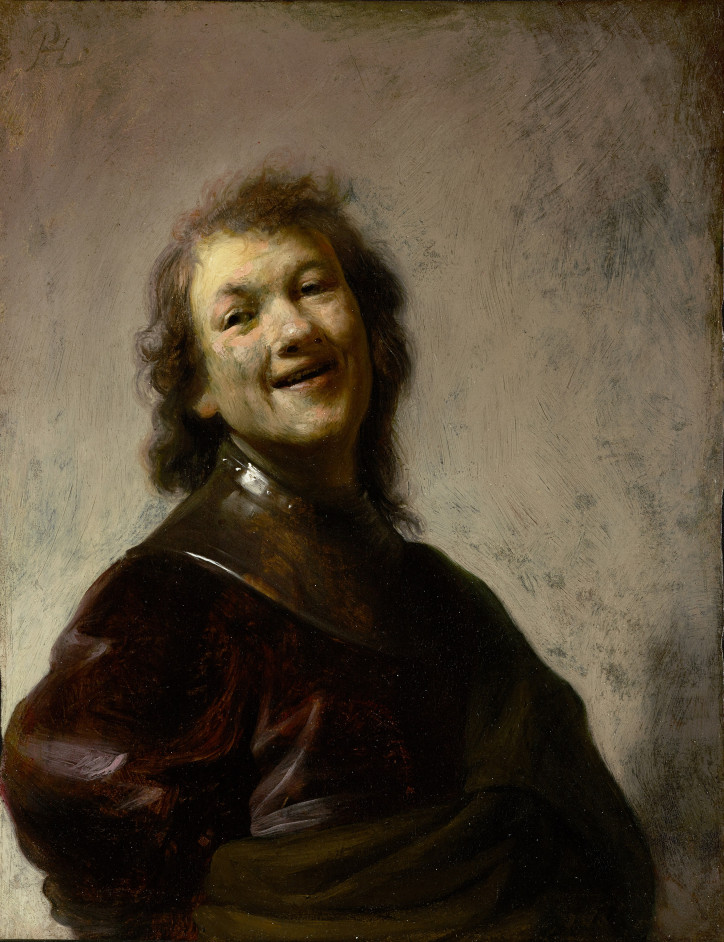
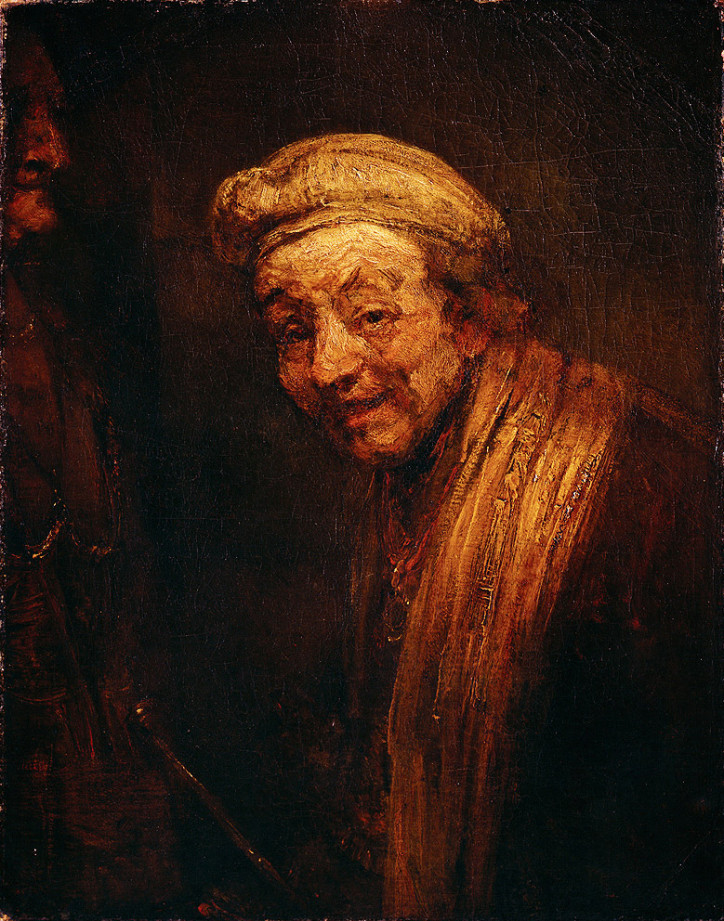
Translated from the Polish by Anna Blasiak


